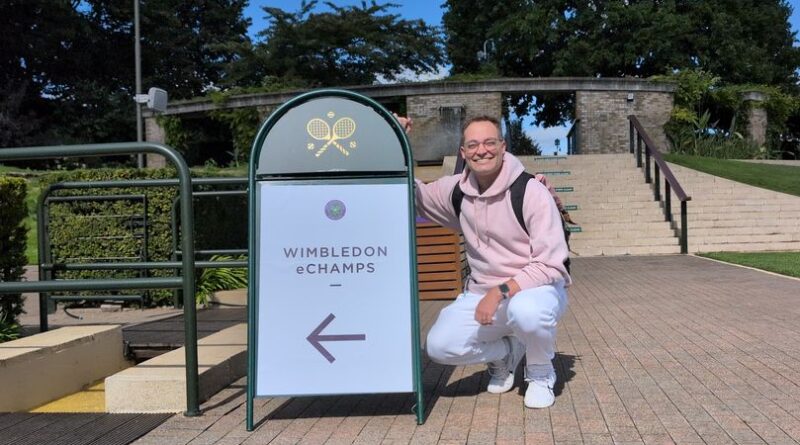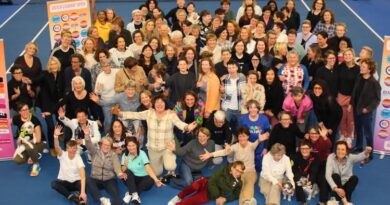GLTA Tennis Player Andrew Schuyler Takes on Wimbledon eTennis Champs
This week, Andrew Schuyler, a tennis player in the GLTA is making waves in the world of eTennis. Andrew, who first picked up a racquet at the age of six, has a long history with real-life tennis—competing in junior tournaments, playing varsity tennis, and even leading the Club Tennis team at the University of Central Florida. But now, his competitive spirit has found a new outlet: eTennis.
As one of the top 8 eTennis players in the world, Andrew has qualified for the prestigious 2024 Wimbledon eChamps tournament in London, where he is competing in TopSpin 2K25, a popular tennis simulation game.
Can you tell us a bit about your journey in tennis? When did you first pick up a racket?
I first picked up a racquet when I was about six years old, growing up in a tennis-loving family in St. Petersburg, Florida. Tennis has been part of my life for as long as I can remember—everyone in my family plays, including my grandparents, parents, and siblings. I trained in Florida, competed in junior tournaments, and played varsity tennis in high school before moving on to play Club Tennis at the University of Central Florida. I also taught tennis for three years at a private club in Florida after graduating from UCF.
What would you say has been the highlight of your career in real-life tennis so far? Any particular tournaments or memorable matches?
One of the highlights was competing in junior tournaments throughout Florida. Even though I never played professionally, I’m proud of the relationships I built and the lessons I learned on the court. Being president of the UCF Club Tennis team during my senior year was also a special experience—leading the team, competing in tournaments, and bonding with my teammates, many of whom I’m still friends with to this day.
How did you first get introduced to eTennis and TopSpin 2K25? Was it something that came naturally alongside your real-life tennis career?
My love for tennis video games developed alongside my real-life tennis career. I’ve played nearly every tennis game out there—starting with the early Top Spin games, Virtua Tennis, and others. When TopSpin 2K25 came out, it felt like a natural fit. It combines my love for tennis with my passion for gaming, and it became a competitive outlet for me, just like real tennis has always been.
For those unfamiliar, could you explain what TopSpin 2K25 is and how the game simulates real tennis?
TopSpin 2K25 is a tennis simulation video game that does an incredible job replicating the nuances of real tennis. It allows players to control the speed, spin, and placement of shots, much like in real life. You can create a player, develop their skills, and compete in tournaments that mirror real-world events. The strategy and timing required in the game reflect real tennis, making it a perfect bridge between the virtual and physical sports worlds.
Tell us about the Wimbledon eChamps tournament. How does it compare to playing in a real-life tennis competition?
The Wimbledon eChamps tournament is one of the biggest eTennis events in the world. Competing in it feels like being part of a real-life tennis tournament, even though it’s virtual. The pressure, the intensity, and the strategy all feel very real. It’s like stepping into a digital version of Wimbledon, where every point counts, and you’re playing against the best in the world.
How do you qualify for a global eSports tournament like the Wimbledon eChamps, and what’s it like competing against the top 8 players in the world?
To qualify, you had to compete in regional qualifier tournaments over the summer. The regions are North America (USA, Canada, Mexico, Puerto Rico), Western Europe (Germany, Spain, Italy), France, and the United Kingdom. The top 2 players from each region were then selected to compete at the Wimbledon eChamps tournament. Playing against the top 8 is intense—they’re all highly skilled, and the level of play is through the roof.
What are some key differences between playing real tennis and competing in an eTennis tournament? Are there any similarities?
The biggest difference is the physical aspect—obviously, real tennis requires stamina and endurance, while eTennis is more about mental focus and reaction time. However, the strategy is similar in both: you still need to read your opponent, plan your shots, and adapt your game as the match progresses.
How do you prepare for a virtual tennis match versus a real one? Is the training process similar or entirely different?
For a real tennis match, preparation involves physical training, footwork drills, and hitting sessions. In eTennis, it’s all about practicing timing, learning your opponents’ tendencies, and perfecting your strategy. Both require a lot of mental focus, but the physical preparation is obviously different.
What skills from real-life tennis translate well into TopSpin 2K25, and are there any aspects of the game that are completely unique to eTennis?
The tactical awareness from real tennis translates well into TopSpin 2K25. Knowing when to go for power or play it safe, recognizing patterns in your opponent’s game, and understanding positioning are key in both. However, eTennis adds an element of timing and precision with the controller that doesn’t exist in real tennis.
Which do you find more challenging: competing on the actual court or playing in a virtual tennis tournament?
Both have their challenges. On the actual court, you’re battling physical exhaustion, but in virtual tennis, it’s an intense mental grind. Staying sharp and focused for long matches in an eTennis tournament can be just as demanding in its own way.
Do you have any particular strategy or favorite player moves that you rely on in TopSpin 2K25, and are they inspired by your real-life game?
In TopSpin 2K25, my strategy revolves around control shots. I focus on moving my opponent around the court, wearing them down, and setting up angle winners. This mirrors my real-life game, where I enjoy playing a tactical, controlled style—using placement and angles to outmaneuver my opponent rather than relying purely on power. It’s all about creating opportunities and taking advantage when the right moment comes.
How do your real-life tennis friends and fellow competitors react to your involvement in eSports?
Most of them were very surprised and think it’s really cool! Others are just amazed that eTennis has grown into something so competitive and respected.
What was your reaction when you learned you qualified for the Wimbledon eChamps tournament?
I was beyond excited! It’s such an honor to qualify for an event like Wimbledon eChamps, especially since it’s tied to such a prestigious real-world tournament. It felt like all the hours of playing and practice had finally paid off.
You’re in London now for the eChamps tournament—how does it feel to be in the city that hosts the iconic Wimbledon tournament, albeit in a virtual setting?
It’s surreal! I’ve never been to Wimbledon before, so just being in London, at Wimbledon, the most prestigious tennis tournament in the world, is incredible. Even though it’s virtual, there’s still something special about competing at Wimbledon event.

With the rise of eSports, do you think virtual tennis could ever become as popular or respected as real-life tennis?
It’s possible! As eSports continues to grow, I think more people will appreciate the skill and strategy involved in virtual tennis. While it may never fully replace real-life tennis, it can definitely complement it and attract new fans to the sport.
What do you think are the biggest misconceptions people have about eSports and virtual tennis?
One misconception is that it’s just “playing video games.” People don’t realize the level of skill, practice, and mental focus required to compete at a high level in eSports. There’s a lot more strategy and technique involved than most people assume.
Where do you see the future of tennis going with the rise of technology and gaming? Could we see more integration between real and virtual competitions?
I think we’re going to see more crossover between real tennis and eTennis. Technology can help enhance the spectator experience, and virtual competitions might even start happening alongside real-world tournaments to bring in a broader audience.
Finally, what advice would you give to someone who’s interested in both real tennis and eTennis? Can both worlds complement each other in a player’s development?
Absolutely! Playing real tennis gives you a better understanding of strategy, positioning, and shot selection, which translates into eTennis. Likewise, eTennis can help with mental focus and decision-making, skills that are important on the real court. Both can complement each other in terms of developing your overall game.




